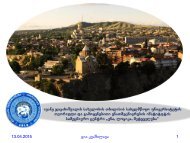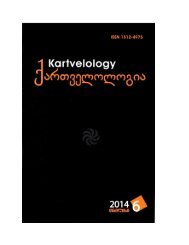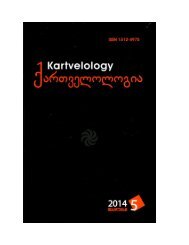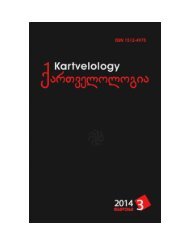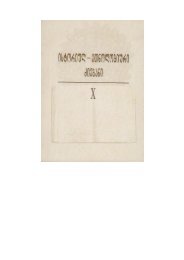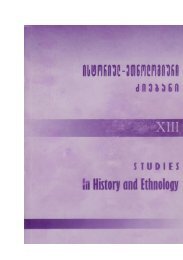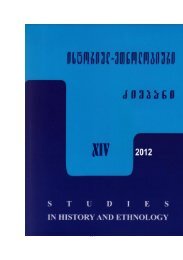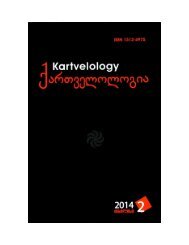Kvashilava, Gia, 2010. On Reading Pictorial Signs of the Phaistos Disk and Related Scripts (2). Rosette (in Georgian and English)
This study concerns the graphic character, symbolic meanings, typological parallels, commentaries and reading of the Phaistos Disk pictorial sign PHD38.
This study concerns the graphic character, symbolic meanings, typological parallels, commentaries and reading of the Phaistos Disk pictorial sign PHD38.
Create successful ePaper yourself
Turn your PDF publications into a flip-book with our unique Google optimized e-Paper software.
Bas<strong>in</strong>g on <strong>the</strong> analysis <strong>of</strong> Strabo (X,3,12) 1 <strong>and</strong> Arrian (X.9) 2<br />
V. Bardavelidze (1957, 81 <strong>and</strong> ff.), O. Lordkipanidze (2000, 90-<br />
96) <strong>and</strong> J. Nadiradze (1989, 136-140) show that <strong>the</strong> Colchian<br />
goddess, Great Mo<strong>the</strong>r Nana or Phasiane is identified with <strong>the</strong><br />
M<strong>in</strong>oan <strong>and</strong> Asiatic Great Mo<strong>the</strong>r Goddess, <strong>the</strong> Earth Goddess,<br />
Goddess <strong>of</strong> <strong>the</strong> Caves <strong>and</strong> <strong>the</strong> Lady <strong>of</strong> <strong>the</strong> Mounta<strong>in</strong> Rhea-<br />
Cybéle 3 (comp.: Evans 1909, 103); on <strong>the</strong> o<strong>the</strong>r h<strong>and</strong>, Cybéle or<br />
Cybébe/Kubaba 4 is connected to: Sumerian<br />
[ d n<strong>in</strong>· ur·saĝ] – N<strong>in</strong>hursag, Lady <strong>of</strong> a Mounta<strong>in</strong> <strong>and</strong> a hill-<br />
1 . Strabo (X,3,12; Jones 1961, V, 99) writes:<br />
“But as for <strong>the</strong> Berecyntes, a tribe <strong>of</strong> Phrygians, <strong>and</strong> <strong>the</strong> Phrygians <strong>in</strong><br />
general, <strong>and</strong> those <strong>of</strong> <strong>the</strong> Trojans who live round Ida, <strong>the</strong>y too hold Rhea <strong>in</strong><br />
honour <strong>and</strong> worshiped her with orgies, call<strong>in</strong>g her Mo<strong>the</strong>r <strong>of</strong> <strong>the</strong> gods <strong>and</strong><br />
Agdistis <strong>and</strong> Phrygia <strong>the</strong> Great Goddess, <strong>and</strong> also, from <strong>the</strong> places where she<br />
is worshipped, Idaea <strong>and</strong> D<strong>in</strong>dymenê <strong>and</strong> Sipylenê <strong>and</strong> Pess<strong>in</strong>untis <strong>and</strong><br />
Cybelê <strong>and</strong> Cybebê” (Jones 1961, V, 99).<br />
2 . Arrian (X.9; H<strong>of</strong>fmann 1842, 50) writes:<br />
“At <strong>the</strong> entrance to <strong>the</strong> Phasis, to <strong>the</strong> left st<strong>and</strong>s Phasian Theos. Judg<strong>in</strong>g<br />
by its appearance this is Rhea; <strong>and</strong> <strong>in</strong>deed, she holds a cymbal <strong>in</strong> her h<strong>and</strong>s,<br />
<strong>and</strong> lions are at <strong>the</strong> throne; <strong>and</strong> she is seated like [Rhea] <strong>of</strong> Phidias at <strong>the</strong><br />
Metroon <strong>in</strong> A<strong>the</strong>ns” (Lordkipanidze 2000, 90).<br />
3 . L. Cottrell (1959) th<strong>in</strong>ks that Pasiphaë, a sister <strong>of</strong> <strong>the</strong> k<strong>in</strong>g <strong>of</strong> Colchis<br />
Aeëtes <strong>and</strong> <strong>the</strong> spouse <strong>of</strong> <strong>the</strong> k<strong>in</strong>g <strong>of</strong> Crete M<strong>in</strong>os, <strong>and</strong> her daughter Ariadne<br />
were priestesses <strong>of</strong> <strong>the</strong> Asian Mo<strong>the</strong>r.<br />
4 . Cybéle/Kybébe/Kubaba is <strong>of</strong>ten identified with <strong>the</strong> Hurrian mo<strong>the</strong>r<br />
goddess (<strong>Kvashilava</strong> 2007, 246-247).<br />
261




